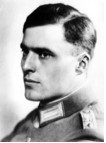 |
| Col. Claus von Stauffenberg (cine.etsas.org ) |
Nazi Germany was one of the worst regimes this world has seen. As with most tyranny, there comes a risk. In most cases this risk is someone’s life. The person I have chosen as my hero put his own life in danger to put an end to the Nazi regime and a blood bath called World War Two. I believe that anyone who puts his own life in danger for the sake of others should be recognized as a hero.
Claus von Staffenberg was born on November 15, 1907; he was the third of four sons in the Stauffenberg family. His aristocratic family consisted of two sets of twins, Claus’ own twin, younger, and his older two brothers. While being brought up in the Stauffenberg Castle in Jettingen, the young Stauffenberg was, like his brothers, carefully educated and grew to enjoy literature. On his mother’s side, Stauffenberg had had two generals in his family who had fought against Napoleon Bonaparte. Contrary to his family’s wishes, Stauffenberg enlisted into the War Academy in Berlin and, at age nineteen, became an officer cadet.
Claus von Stauffenberg served as a combatant in all of Reichfuehrer Adolf Hitler’s major military campaigns. These included everything from Sudetenland to Poland and France to Tunisia. From the end of May 1940 until the end of January 1943, Staffenberg served in the Army High Command General Staff Headquarters. And, in early 1943, Stauffenberg served in the 10th Panzer Division in Field Marshall Rommel’s Afrika Korps. While in the Afrika Korps in the North African Desert Stauffenberg was seriously wounded when allied fighters strafed his vehicle. Following surgery the Colonel had lost his left eye, right hand, and the last two fingers on his left hand
Staffenberg became appalled at the atrocities of the SS, SD, and Security Police during Operation Barborossa. He particularly was upset over the murder of Jewish citizens in the U.S.S.R. And equally so, in excess, of what the German Army was doing to Soviet Prisoners of War. The treatment of the Soviet civilian population was too appalling; Staffenberg made his disgust clear to Major Kun in August of 1942. Later that same year Stauffenberg made the decision that the Nazi Regime must be overthrown, and that he would have to help.
Staffenberg had spent the summer of 1942 attempting to persuade Senior Commanders of the atrocities of the regime. He made the decision in September 1942 that he himself was prepared to kill Hitler. In 1943 the Colonel agreed to join the civilian side of the German Resistance. The plot involved many decorated military men including Wilhelm Canari, Carl Goerdeler, Julius Leber, Ulrich Hassell, Hans Oster, Henning von Tresckow, Fabian von Schlabrendorff, Peter Graf Yorck von Waternburg, Ludwig von Beck, and Erwin von Witzelben.
If everything were to go according to plan, Beck, von Witzelben, and Fromm would take control of the German Army as well as seize control of key government buildings, telephone and signal centres, and radio stations, after Hitler, Goering, and Himmler were deceased. Von Stauffenberg was to become the State Secretary of the War Ministry in the post-coup government.
On July 11 Stauffenberg brought explosives, concealed in a briefcase, to Adolf Hitler’s Berghof Residence. Stauffenberg would have killed him there, however circumstances beyond his control prevented him from conducting the operation. Only four days later Claus von Stauffenberg flew to the fuehrer’s the ‘Wolf’s Lair’, along with co-conspirator Captain Klausing.
Colonel Stauffenberg had been ordered by senior conspirators in Berlin to abort the attempt after telephoning to report the absence of Himmler, and Luftwaffe Air Marshall Goering from the briefing, he had secretly agreed with Colonel von Mertz to continue. Stauffenberg later found out that the session had ended after only five minutes.
On July 20, 1943 Claus von Stauffenberg flew to the Wolf’s Lair with aide, and co-conspirator Lt. Haeften. Colonel Stauffenberg, who had never met the dictator before, carried the briefcase, with explosives inside, and placed it on the floor in the briefing room as he left to take a phone call. When the bomb went off Claus von Stauffenberg was on his way out of the residence and heading back to Berlin to take on the second phase of the operation.
Meanwhile, co-conspirator Olbricht had neglected to set the coup in motion during the first two hours after the attempt had been made. The plan had become a complete failure, without killing the Fuehrer and without seizing any radio stations or being able to retain authority over reserve Army Troops in Berlin. Once the radios broadcasted that Hitler had survived the attack the conspirators knew that the operation had ultimately failed.
In an attempt to protect himself, Fromm organized the execution of four conspirators, including Staffenberg. On July 21, 1944 at 12:30 in the morning Colonel Claus von Staffenberg was executed by a firing squad in the courtyard of the War Ministry. It was later reported that he had died shouting ‘LONG LIVE FREE GERMANY!’
Nine months later, on April 30, 1945, Reichfuerhur Adolf Hitler committed suicide as allied combatants moved in on Berlin. His cause of death has been debated between a gunshot and a cyanide poison.
-BIBLIOGRAPHY- Information Courtesy of-
“Claus von Staffenberg Jewish Virtual Library. American-Israeli Enterprise. Copyright 2009. October 13, 2009 www.jewishvirtuallibrary.org/jsource/biography/Stauffenberg.html
Claus Schenk Graf von Staffenberg Wikipedia.com. Wikimedia Foundation, Inc. 13 October 2009. 13 October 2009 en.wikipedia.org/wiki/Claus_Schenk_Graf_von_Stauffenberg
"Claus Philip Schenk von Staffenberg." Biography Resource Center Online. Gale, 2004. Reproduced in Biography Resource Center. Farmington Hills, Mich.: Gale, 2009. http://galenet.galegroup.com/servlet/BioRC Document Number: K1650004325 Pictures Courtesy of- Staffenberg Portrait- cine.etsas.org
Page created on 11/17/2009 12:00:00 AM
Last edited 11/17/2009 12:00:00 AM
